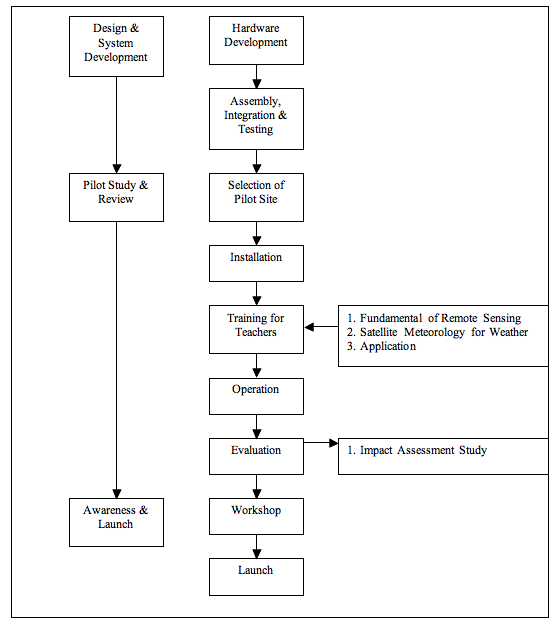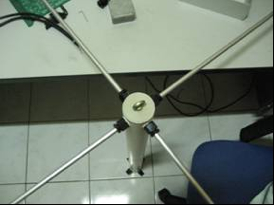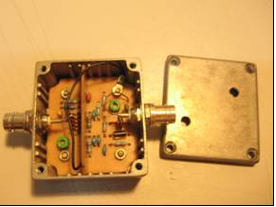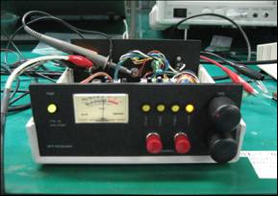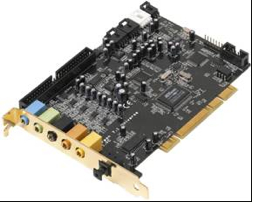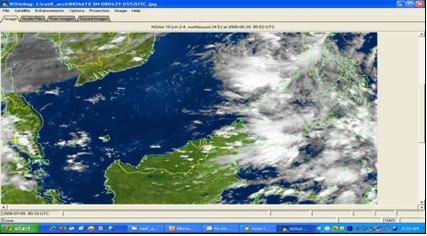Scope of Study The success of EGRS is not only to receive the NOAA satellite imagery but to fully exploit the data output by teachers and students for weather and various remote sensing applications. Thus the scope of study for the EGRS would emphasize on the following criteria:
METHODOLOGY The implementation of EARS will be divided into three phases:
Figure 1: Process Flow for Introducing the Educational Ground Receiving System at School Level
Design and System Development During the design and system development phase, the system requirements and specifications were identified in order to be capable of receiving the transmitted data from the NOAA satellite. Trade studies were carried out between design and cost in order to minimize the cost of the final APT system. Finally, the system will be assembled, integrated and tested prior to the second stage of launching the system at pilot sites for operation and review by selected schools. The antenna will be designed in kits form to enable students and teachers to have hands on for the setting up of the antenna and finally install and operate the whole system with minimal supervision by the developer. The three development phases of the system identified were:
Signal Acquisition Level The signal acquisition level consists of the development of the antenna, low noise amplifier, receiver and tracking software.
Figure 2: Antenna The antenna is to receive the electromagnetic radiation (EMR) in radio frequency (RF) signal. The RF range to be received is between 137 to 138 MHz.
Figure 3 : Low Noise Amplifiers (LNA) The LNA is to amplify the incoming RF signal and feed it to the receiver.
Figure 4: Receiver The receiver is to demodulate (extract information) the received signal and transform it into audio format.
Figure 5: Tracking Software The tracking software is required to determine the satellite path and pass for acquisition schedule. Figure 5 shows the WXtrack tracking software that is made freely available from the internet (David and Cecilia, 2008).
Acquisition Option Two types of acquisition option can be provided. For educational level, the human intervention is proposed to allow for interactive students’ activity during data acquisition. Students will use the tracking software to determine the satellite path and pass for acquisition schedule. Again, students will have the chance to select and control the frequency using the receiver to demodulate (extract information) the received signal and transform it into audio format. The fully automated acquisition will allow for pass control in the absence of human intervention. This option provides satellite monitoring by emitting the signal from the serial port to instruct pass control hardware to switch to the appropriate frequency of the passing signal.
Conversion Level The conversion level is to convert the audio signal received from the receiver to digital format (A-D conversion).
Figure 6: Sample of PC Card Processing Level The processing software is required to process the digital format into image format as shown in Figure 7 using the WXtoImg processing software. For the EGRS which receives the APT, only visible (VIS) & near-infrared (NIR) bands are acquired during day time acquisition while NIR band for night time acquisition.
Figure 7: Processing SoftwareTable 2: NOAA Series Received
Number of acquisition per day and night is 12 passes to provide 12 data set.
Preliminary Results Some preliminary results were obtained by the system during the development phase. Figure 7 a show data captured from NOAA15 satellite on July 2, 2008 at 2147UTC while b shows data captured from NOAA17 on May 4, 2008 at 1458UTC.
Figure 7: NOAA Data Captured Using the Educational Ground Receiving System
Pilot Study and Review The study proposes for the system to be installed and operated at selected schools with the objective of getting early comments and review from teachers and students on the effectiveness of the EGRS in achieving the objective of creating interest in innovation and scientific environment at school level. For a start, the system will be established in Kuala Lumpur Infrastructure University College (KLIUC) as a tool in teaching remote sensing under the Geomatic Engineering program, Civil Engineering Department, School of Engineering & Technology Infrastructure (SOETI) as contributed by Axis Commerce Sdn. Bhd., the developer of the EGRS. At school level, teachers will be provided with training in fundamental remote sensing and guides to (i) install and operate the EGRS, and (ii) extract information from image data. Thus, fundamental remote sensing is a pre-requisite for teachers to understand before exploiting the image data. Upon completion of training, teachers will then be capable of (i) managing the students to operate and maintain the EGRS, and (ii) educating remote sensing to students and extract information from satellite imagery. Comments and review by teachers will then help to refine the system and training guides before proceeding to the last stage of awareness and launching the system to other schools interested in EGRS.
Remote Sensing Applications NOAA satellite for weather is related to remote sensing of the atmosphere which attempts to quantify numerous variables: cloud coverage and identity, water vapour concentration and precipitation rate, wind speeds, atmospheric aerosol and trace gas concentrations, and even lightning in storms. The term atmosphere has led to the creation of several other words to describe various divisions of the Earth’s environmental systems. The hydrosphere, encompassing oceans, rivers, lakes and snow and, ice on both land and sea. The biosphere, referring to the living things that inhabit the Earth, which for remote sensing purposes primarily means land vegetation and oceanic phytoplankton. The geosphere, covering such areas as the Earth’s radiation budget, the physical topography of the continents, geological processes that modify the land surface, the dynamic activity of volcanoes and the movement of the Earths’s continental plates. The anthroposphere, meaning the influence of humanity on the surface of the Earth through structures and activity that have the potential to significantly alter the Earth’s climate (UN, 2003). Thus, the introduction of EGRS would benefit education in various applications besides allowing the students to understand the fundamental of remote sensing. At school level, specific educational modules would be designed according to the primary processes that remote sensing seeks to measure in some of these spheres. As this paper is written with the objective of showing the general overview to introduce the system at educational level, the various applications mentioned above would be derived after the acquisition of the data and covered thoroughly in the later stage of the program that would highlight not only the exploitation of the data, but, understanding the basics of remote sensing, NOAA sensor systems and capability of bands for remote sensing utilization. Nevertheless, the feasible applications were mentioned briefly here with the intention of creating interest by showing what could be learnt and applied to benefit not only at educational level but for various operational applications too.
Awareness and Launch Upon the successful pilot study, an awareness program of EGRS for schools will be organized. The objective of the awareness program is to allow the selected schools during the pilot study to share the experience of using EGRS for other schools to enjoy the benefit of using space related technologies in creating interest in innovation and scientific environment at school level. Hence, the awareness program would also be a good start to identify schools that are interested in EARS. This might pave a way for finding agencies that can provide funding for educational benefits to schools that are interested in procuring the EARS. The awareness program shall include workshops for the participating schools to provide feedback and finally to produce an impact study report of the EGRS. As the approach to introduce the system to other schools shall be well panned, refinement of any comments shall assess and observed. Only then, installations will be carried out to other interested schools. The awareness program shall be continued by having workshops from time to time to get more feedback on how the EGRS has successfully achieve its objectives.
CONCLUDING REMARKS Hopefully, EGRS can achieve its objective in creating interest in innovation and scientific environment by providing gizmo in kits form for students to assemble a micro ground receiving station in school and enabling the reception of NOAA weather satellite imagery data in real time at their finger tips. The introduction of EGRS will not change any of the school syllabuses but provides VAPs to complement some of the school subjects besides acting as catalyst to introduce other innovative products related to space related technologies. Although, in this paper, EGRS is aimed to be introduced at school level, it would also be good to introduce EGRS at tertiary level as a way to complement the remote sensing subject for better understanding of its fundamentals. The system will also benefit various agencies which are involved in remote sensing applications of the environment. Finally, the educational system will pave the way for school children to understand the importance of remote sensing and the imaging satellite program of the nation such as the RazakSAT, the second remote sensing satellite after the TiungSAT-1 which was launched on September 26, 2000. As Malaysia would launch the RazakSAT by September 2008, thus, by introducing the system, we are creating the future beneficiaries of remote sensing data in ensuring the data is being exploited and the satellite program is a success besides creating sustainability in space related technologies and programs.
ACKNOWLEDGEMENT The authors would like to acknowledge Axis Commerce (M) Sdn Bhd for providing the EGRS to KLIUC. REFERENCES Berman, E. A. (1991). Teacher’s Guide for Using APT Satellite Imagery to Teach Science and Math. National Oceanic and Atmospheric Administration (NOAA), U.S. Department of Commerce. Tri-Space, Inc. MC Lean, Virginia. David T. and Cecilia T. (2008). Weather Satellite Tools from SatSignal Software. http://www.satsignal.eu/software/wxsat.htm Jensen, J.R. (1996). Introductory Digital Image Processing: A Remote Sensing Perspective. 2nd ed. Prentice-hall, USA. Kasturi D. K., Mazlan H. and Mohd Ibrahim S.M. (2000). A Systematic Approach in Remote Sensing Education and Training at Universiti Teknologi Malaysia. 21st Asian Conference on Remote Sensing. Taipei, Taiwan. December 4-8, 2000. http://www.gisdevelopment.net/aars/acrs/2000/ps2/ps207.asp Mohd Zambri, Z (2007). Perspective of Space Science Education and Awareness in Malaysia. Thai National Astronomy Meeting 2007, Nakorn Pathom. 22-24 March, 2007. http://www.narit.or.th/tnam2007/paper/Zainuddin-Zambri.pdf NASA (2008). NASA - NASA for Students.National Aeronautics and Space Administration. http://www.nasa.gov/audience/forstudents/index.html Sarepta (2008). Sarepta – Using Space in Education. Norwegian Centre for Space-related Education and Norwegian Space Centre. http://www.sarepta.org/en/index.php United Nation (2003). “Remote Sensing and the Geographic Information System – Education Curriculum”. Regional Centres for Space Science and Technology Education. New York.
Copyright for articles published in this journal is retained by the authors, with first publication rights granted to the journal. By virtue of their appearance in this open access journal, articles are free to use, with proper attribution, in educational and other non-commercial settings. Original article at: http://ijedict.dec.uwi.edu//viewarticle.php?id=602&layout=html
|
